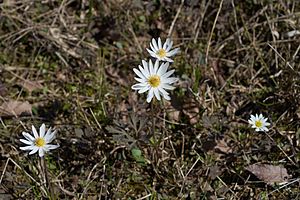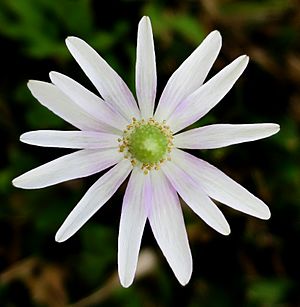Carolina anemone facts for kids
Quick facts for kids Carolina anemone |
|
|---|---|
 |
|
| A. caroliniana flower | |
| Scientific classification | |
| Genus: |
Anemone
|
| Species: |
caroliniana
|
| Forms & Varieties * |
|
|
|
| Synonyms | |
|
|
The Anemone caroliniana, also called the Carolina anemone, is a type of flowering plant. It's a herbaceous plant, meaning it has soft, green stems instead of woody ones. This pretty flower is part of the buttercup family, known as Ranunculaceae.
These plants usually grow to be about 10 to 40 centimeters tall. They grow from short, thick underground stems called rhizomes, which are like small tubers. The leaves on the stem do not have stalks. Carolina anemones bloom in early to mid-spring. Each stem has one flower. The flowers have 10 to 20 sepals, which look like petals. These sepals are usually white or light pink, but can also be purple. They are about 10 to 22 millimeters long. After flowering, the plant produces fruits in a head that looks like an oval or cylinder, about 17 to 25 millimeters long.
Where It Grows
The Carolina anemone is native to the central and southeastern parts of the U.S.. You can mostly find it in the Great Plains and the Mississippi Valley. There are also some groups of these plants scattered in the Southeast. These include areas from Tennessee and Mississippi all the way to the Carolinas.
Sadly, the Carolina anemone used to grow in Vigo County, Indiana. But now, it no longer grows there. This means it has become locally extinct in that state.
Where It Likes to Live
Anemone caroliniana prefers to grow in dry areas. You can find it in open grasslands called prairies. It also grows in barren lands and open, rocky woods.


